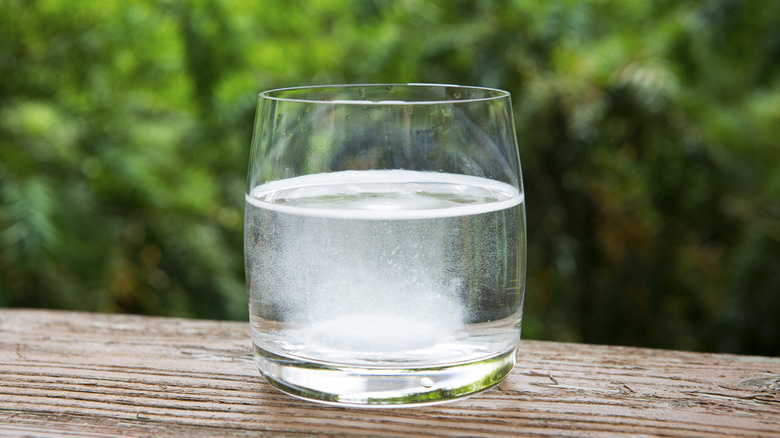How To Calculate Molar Solubility From KSP?
When a slightly soluble ionic compound is placed in water, there is an equilibrium between the solid state and the aqueous ions. This is found by the equilibrium constant for the reaction.
What Is Ksp?
What Is Ksp?
Take a look at the reaction that occurs when silver (I) chloride dissolves in water:
\(AgCl(s) \rightarrow Ag^+(aq)+Cl^-(aq)\)
When the solution is saturated, the dissolving of AgCl and formation of solid AgCl are occurring at the same time, or the reaction is at equilibrium:
\(AgCl(s) \leftrightharpoons Ag^+(aq)+Cl^-(aq)\)
The equilibrium constant can be written where the power on the components is the coefficient in the balanced equation:
\(K = \dfract{[Ag^+][Cl^-]}{[AgCl]}\)
Since there is no concentration for the solid AgCl, this can be removed from the equation. The resulting K value is called Ksp or the solubility product:
\(K_{sp} = [Ag^+][Cl^-]\)
Ksp is a function of temperature. Say that the Ksp for AgCl is 1.7 x 10-10. With this information, you can find the molar solubility which is the number of moles that can be dissolved per liter solution until the solution becomes saturated. The units are given in moles per L, otherwise known as mol/L or M.
A saturated solution is a solution in which the maximum amount of solute has been dissolved at a given temperature.
An unsaturated solution is a solution in which all solute has completely dissolved in the solution.
Finding Molar Solubility From Ksp
Finding Molar Solubility From Ksp
Given that the Ksp for AgCl is 1.7 x 10-10, you can find the molar solubility, or the concentration of either ion in the solution:
\(1.7 \times 10^{-10} = [Ag^+][Cl^-]\)
Now what? There are two variables: [Ag+] and [Cl-], so how can you solve for the molar solubility? Since these ions come from the same solid, it is impossible that there is more of one than the other. This means that [Ag+] = [Cl-]. So:
\(1.7 \times 10^{-10} = (x) \times (x)\)
or,
\(1.7 \times 10^{-10} = x^2\)
Taking the square root of both sides allows you to solve for the molar solubility:
\(x = 1.3 \times 10^{-5} M\)
Thus, the molar solubility of both Ag+ and Cl- is thus 1.3 x 10-5 M.
Finding Ksp From Molar Solubility
Finding Ksp From Molar Solubility
Given molar solubility for the ions in question and the balanced equation, you can find the Ksp.
Consider the following equation:
\(CaF_2 (s) \leftrightharpoons Ca^{2+}(aq) + 2F^-(aq)\)
The solubility product is written as such:
\(K_{sp} = [Ca^{2+}][F^-]^2\)
Remember: The [F-] must be raised to the second power due to the coefficient in the balanced equation.
Now, given that the molar solubility is 2.2 x 10-3 M, you can plug this into the equation for both [F-] and [Ca2+]. Remember that the molar solubility must be the same for both since they come from the same compound.
\(K_{sp} = [2.2 \times 10^{-3}][2.2 \times 10^-3]^2\)
So,
\(K_{sp} = 4.0 \times 10^{-8}\)
Factors Affecting Solubility
Factors Affecting Solubility
Solubility is affected by multiple factors.
1. Solids becomes more soluble as temperature increases. 2. As pressure increases, gases become more soluble. 3. The common-ion effect describes a decrease in solubility of an ionic compound when the solution already contains an ion that is the same as one from the compound. 4. Solvent properties: A polar solvent will best dissolve a polar compound while a nonpolar solvent will best dissolve a nonpolar compound.
Cite This Article
MLA
Gupta, Riti. "How To Calculate Molar Solubility From KSP?" sciencing.com, https://www.sciencing.com/how-to-calculate-molar-solubility-from-ksp-13710255/. 16 February 2020.
APA
Gupta, Riti. (2020, February 16). How To Calculate Molar Solubility From KSP?. sciencing.com. Retrieved from https://www.sciencing.com/how-to-calculate-molar-solubility-from-ksp-13710255/
Chicago
Gupta, Riti. How To Calculate Molar Solubility From KSP? last modified March 24, 2022. https://www.sciencing.com/how-to-calculate-molar-solubility-from-ksp-13710255/
